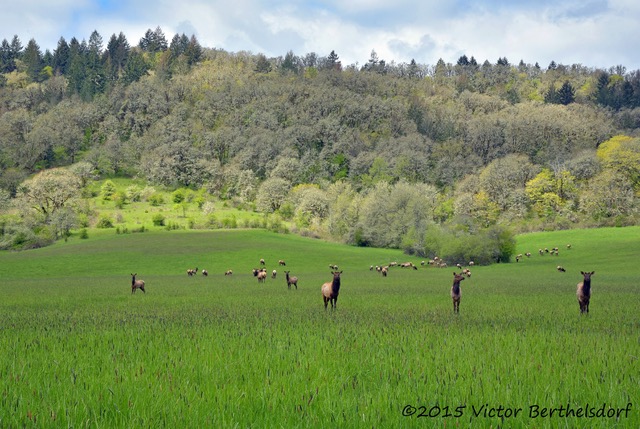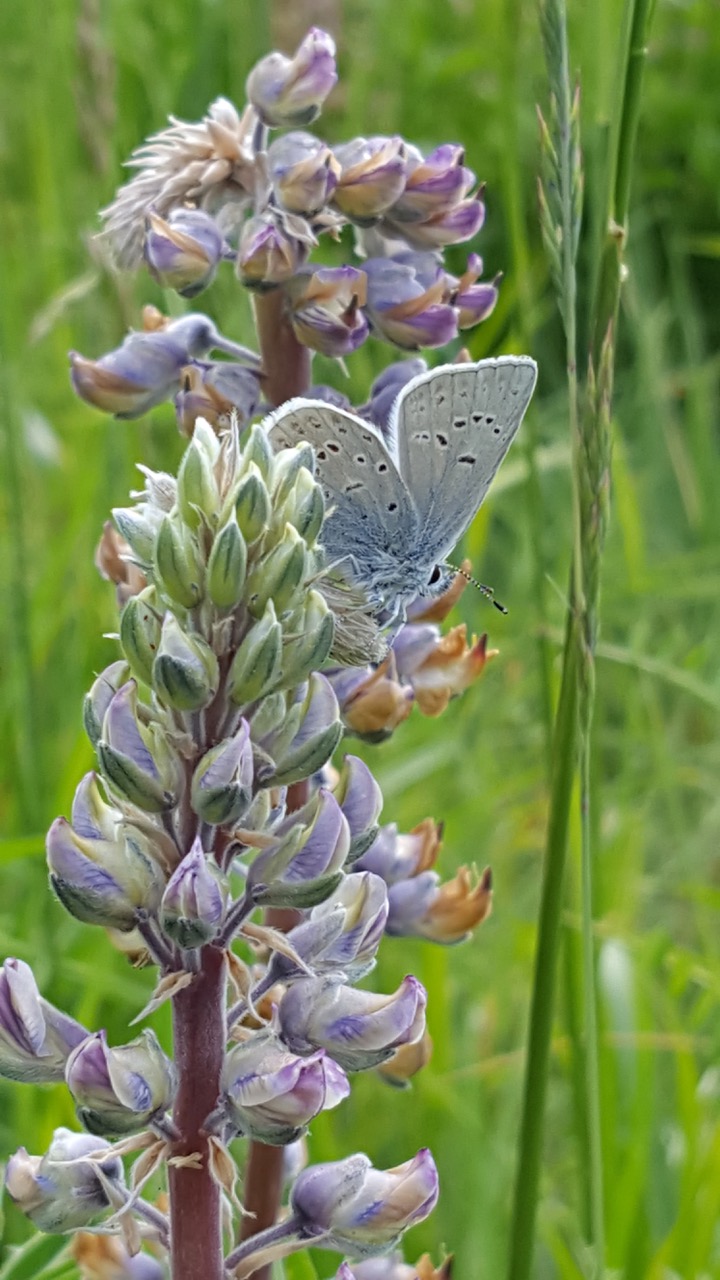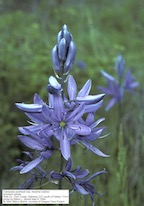NPSO 2024 Annual Meeting
May 17 - 19 Spirit Mountain Hotel, Grand Ronde, Oregon
Field Trips
Saturday May 18, 2024 9 a.m. - 4 p.m. Field Trip # 22
Masonville and Muddy Valley Habitat Reserves

The resident elk herd makes regular appearances on the Muddy Valley Habitat Reserve.
Difficulty: Easy to moderate (2- to 3-mile hikes at each site) - No established trails, uneven ground
Elevation: 400 feet elevation gain
Group Size Limit: 15
 Photo: Amie Loop-Frison
Photo: Amie Loop-Frison
A Fender's blue butterfly feeds on Kincaid's lupine, Lupinus oreganus. Healthy populations of Kincaid's lupine at the Muddy Valley site provide seeds for propagation.
Trip Description: The morning will be spent at the 314-acre Masonville Habitat Reserve. The late Ted and Harriet Gahr, Cheahmill Chapter members, owned the property and added many native plants. The Nature Conservancy bought the property in 2010 and transferred it to Yamhill Soil and Water Conservation District in 2018. Partnerships among several agencies, including the US Fish and Wildlife Service and Natural Resources Conservation Service, have enabled a transition to higher quality habitats, and the site is becoming a functional wet prairie, with riparian, marsh, and upland white oak communities.
Douglas fir were removed to release oaks, followed by seeding native grasses and forbs in the understory. The wetlands received intensive work to remove invasive species and drain tiles. Non-functioning berms were reconfigured so water could move more naturally; seeds, bulbs, and plugs were planted. Expect to see Tolmie's mariposa lily (Calochortus tolmiei), fool's onion (Triteleia hyacinthina), forked-tooth ookow (Dichelostemma congestum), California oat grass (Danthonia californica), checkermallows (Sidalcia nelsonii and S. campestris), small-flowered lotus (Acmispon parviflorus), barestemmed desert parsley (Lomatium nudicaule), and tarweed (Madia sp).
This tour will provide a good overview of how restoration works on large, diverse properties using resources contributed by many agencies.
After lunch, we will visit the 540-acre Muddy Valley Habitat Reserve. It includes a former hayfield, now wet prairie, Muddy Creek, upland oak woodland and savanna, and a mixed species forest. Six ponds are home to one of the largest populations of western pond turtles in the Willamette Valley.
The goal is to restore ecological function across the property while protecting existing remnant native populations. Wetland plants, such as popcorn flower (Plagiobothrys sp.), western yellow cress (Rorippa curvisiliqua), straight-beaked buttercup (Ranunculus orthorhyncus), native sedges (Carex), and grasses grow in the wetland. The hillsides have a natural population of Kincaid's lupine (Lupinus oreganus), along with Tolmie's cat's ear (Calochortus tolmiei), two species of Clarkia (C. amoena and C. purpurea), deltoid balsamroot (Balsamorhiza deltoidea), and narrow-leaved mule's ear (Wyethia angustifolia). Most of the prairie species native to the area can be found here.
Both sites are managed by the Yamhill Soil & Water Conservation District and are not generally open to the public. Participants are encouraged to help generate plant lists for both sites.
Appropriate Clothing and Footwear: Waterproof footwear and hiking poles recommended.
Special Considerations: Poison oak in uplands.
Meeting Place and Time: Trip # 22 leaves at 9 a.m. from parking lot west of Hotel. Plan to arrive 30 minutes before departure time to meet your group and arrange carpools.
Driving Miles and Time from Spirit Mountain Hotel: 23 miles, 30 minutes on paved roads; parking on grass
Driving Directions: Trip leaders will provide detailed driving instructions.
Leaders: Josh Togstad, Chris Seal
Josh Togstad, Protected Lands Manager, Yamhill Soil & Water Conservation District. Chris Seal, Wildlife Biologist, USFWS.


